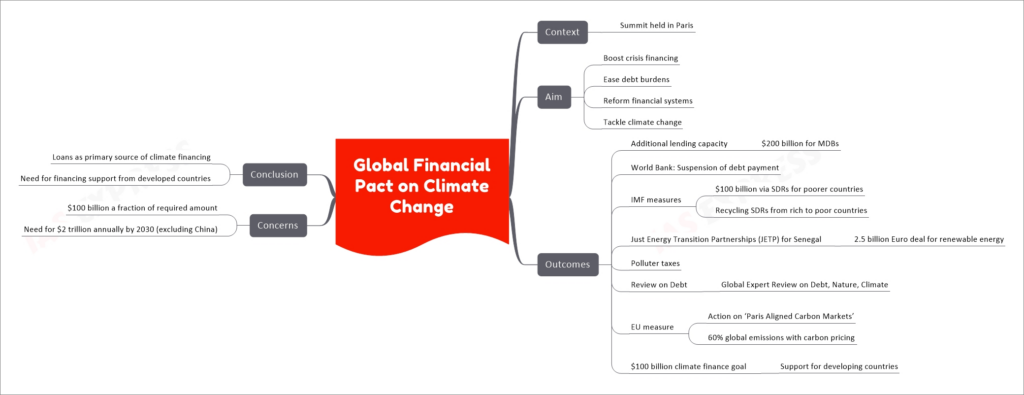Global Financial Pact on Climate Change
This topic of “Global Financial Pact on Climate Change” is important from the perspective of the UPSC IAS Examination, which falls under General Studies Portion.
Introduction
- The Global Financial Pact on Climate Change was established to address the urgent need for financial resources to combat climate change.
- The pact was discussed and formulated at a summit held in Paris, where world leaders and financial institutions came together to find solutions.
- It aimed to address the financial challenges faced by countries in their efforts to mitigate and adapt to climate change.
Aim
The Global Financial Pact on Climate Change aimed to achieve the following objectives:
- Boost crisis financing:
- Provide immediate financial support to countries affected by climate-related disasters.
- Ensure adequate funding for disaster response and recovery efforts.
- Ease debt burdens:
- Explore mechanisms to alleviate the debt burden on climate-vulnerable countries.
- Develop strategies to restructure debt and provide relief to countries struggling with repayment.
- Reform financial systems:
- Foster reforms in the global financial systems to integrate climate considerations.
- Encourage sustainable investment practices and align financial flows with climate goals.
- Tackle climate change:
- Mobilize substantial resources to fund climate change mitigation and adaptation projects.
- Support the development and deployment of clean energy technologies and sustainable practices.
Outcomes
The Global Financial Pact on Climate Change resulted in several significant outcomes:
- Additional lending capacity:
- Multilateral Development Banks (MDBs) received an increased lending capacity of $200 billion.
- This additional funding aimed to support climate-related projects and initiatives.
- World Bank: Suspension of debt payment:
- The World Bank agreed to suspend debt payments for eligible countries facing severe climate impacts.
- This measure provided temporary relief and allowed affected countries to allocate resources to climate actions.
- IMF measures:
- The International Monetary Fund (IMF) allocated $100 billion through Special Drawing Rights (SDRs) for poorer countries.
- SDRs were also recycled from rich to poor countries, ensuring a more equitable distribution of financial resources.
- Just Energy Transition Partnerships (JETP) for Senegal:
- A significant achievement of the pact was the establishment of the Just Energy Transition Partnerships (JETP) for Senegal.
- A 2.5 billion Euro deal was reached to support the development and implementation of renewable energy projects in Senegal.
- Polluter taxes:
- The pact emphasized the implementation of polluter taxes to incentivize carbon reduction and fund climate initiatives.
- These taxes would hold industries accountable for their environmental impact and generate funds for climate financing.
- Review on Debt:
- A Global Expert Review on Debt, Nature, and Climate was initiated to assess the impact of debt on climate-related issues.
- This review aimed to identify strategies to address the intersection of debt and climate change.
- EU measure:
- The European Union (EU) took action on ‘Paris Aligned Carbon Markets,’ promoting carbon pricing as a tool to reduce emissions.
- It was estimated that carbon pricing covered approximately 60% of global emissions, further incentivizing emission reductions.
- $100 billion climate finance goal:
- The pact reaffirmed the commitment to the $100 billion climate finance goal.
- Developed countries pledged to provide financial support to developing countries to assist in their climate change mitigation and adaptation efforts.
Concerns
Despite the achievements of the Global Financial Pact on Climate Change, there were several concerns raised:
$100 billion a fraction of required amount:
- Critics argued that the $100 billion pledged by developed countries was insufficient compared to the actual funding required.
- It was estimated that an annual investment of $2 trillion would be needed by 2030, excluding China, to adequately address climate change.
Conclusion
In conclusion, the Global Financial Pact on Climate Change recognized the need for substantial financial resources to combat climate change. It emphasized the importance of loans as the primary source of climate financing and called for financing support from developed countries. While the pact achieved significant outcomes, such as increased lending capacity, debt suspension, and just energy transition partnerships, concerns remained regarding the adequacy of the pledged funds. Addressing climate change requires a collaborative and sustained effort from all stakeholders to ensure the availability of adequate financial resources for climate action.


